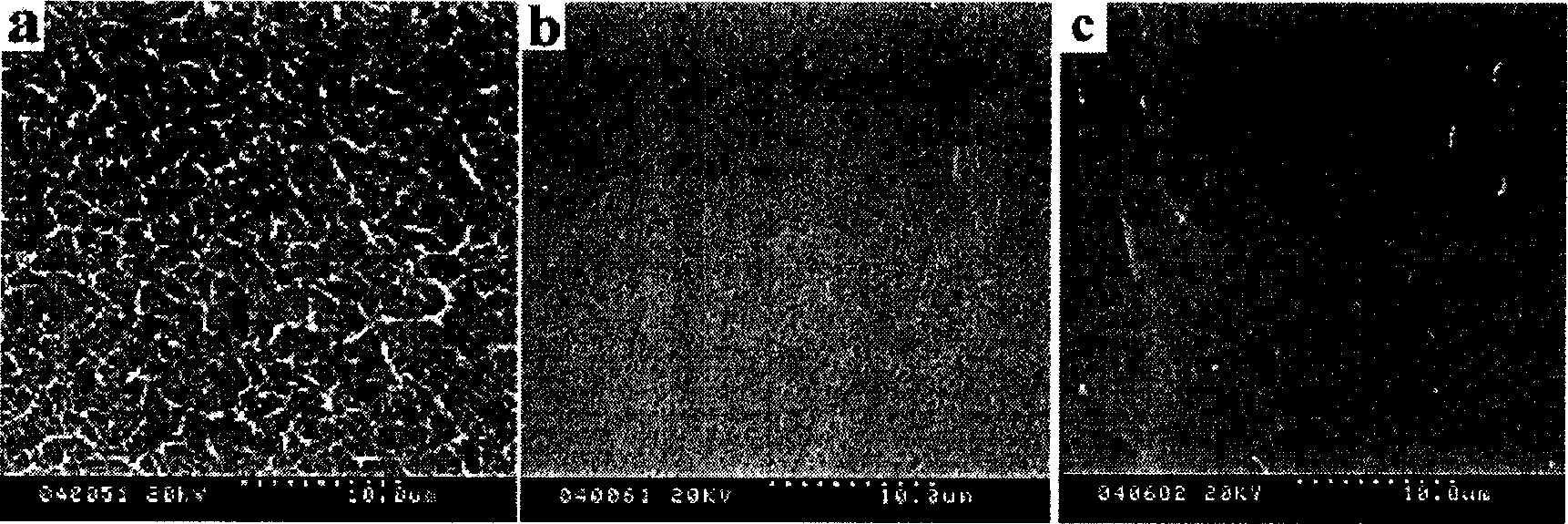Microporous membrane and its preparing process and use thereof
A technology of microporous membrane and porous net, applied in chemical instruments and methods, membrane technology, semi-permeable membrane separation, etc., can solve the problems of slow development of industrial production, difficulty in large-scale industrialization, high spinning temperature, etc., and achieve production cost Effects of low cost, narrow pore size distribution, and simple manufacturing method
- Summary
- Abstract
- Description
- Claims
- Application Information
AI Technical Summary
Problems solved by technology
Method used
Image
Examples
Embodiment 1
[0014] Take 8.4 g of cotton linter cellulose pulp (500 degree of polymerization), add 200 g of 7wt% NaOH / 12wt% urea mixed aqueous solution precooled to -10°C, stir at room temperature for 5 minutes, and the cellulose is completely dissolved. Centrifuge at 10,000 rpm at 15° C. for 30 minutes with an ultracentrifuge to degas it to obtain a transparent cellulose solution. Use a glass tube with copper wires (diameter 0.5mm) tied at both ends to scrape the film on the glass plate and immediately put it in 15°C and 15wt%Na 2 SO 4 After coagulation and regeneration in the aqueous solution for 15 minutes, take it out and rinse it with water. Wet membranes were kept in 2 wt% formaldehyde / 20 wt% isopropanol aqueous solution as porous membranes for separation and permeation etc. The wet membranes were directly subjected to pore size and water flux measurements. In order to measure its mechanical properties, the wet film is pasted on a plexiglass plate and dried naturally in the air to...
Embodiment 2
[0016] Take 8.4 g of cotton linter cellulose pulp (polymerization degree 500), add 200 g of 7wt% NaOH / 11wt% urea mixed aqueous solution precooled to -12°C, stir at room temperature for 5 minutes, and the cellulose is completely dissolved. Centrifuge at 10,000 rpm at 15° C. for 30 minutes with an ultracentrifuge to degas it to obtain a transparent cellulose solution. Use a glass tube with copper wires (diameter 0.5mm) tied at both ends to scrape the film on the glass plate and immediately put it in 25°C, 5wt% (NH 4 ) 2 SO 4 After coagulation and regeneration in the aqueous solution for 10 minutes, take it out and rinse it with water. Wet membranes were kept in 2 wt% formaldehyde / 20 wt% isopropanol aqueous solution as porous membranes for separation and permeation etc. The wet membranes were directly subjected to pore size and water flux measurements. In order to measure its mechanical properties, the wet film is pasted on a plexiglass plate and dried naturally in the air to...
Embodiment 3
[0018] Take 8.4 g of cotton linter cellulose pulp (500 degree of polymerization), add 200 g of 7wt% NaOH / 12wt% urea mixed aqueous solution precooled to -10°C, stir at room temperature for 5 minutes, and the cellulose is completely dissolved. Centrifuge at 10,000 rpm at 15° C. for 30 minutes with an ultracentrifuge to degas it to obtain a transparent cellulose solution. Use a glass tube with copper wires (diameter 0.5mm) tied at both ends to scrape the film on the glass plate, immediately put it in pure water at 25°C to solidify, regenerate for 15 minutes, take it out, and rinse it with water. Wet membranes were kept in 2 wt% formaldehyde / 20 wt% isopropanol aqueous solution as porous membranes for separation and permeation etc. The wet membranes were directly subjected to pore size and water flux measurements. In order to measure its mechanical properties, the wet film is pasted on a plexiglass plate and dried naturally in the air to obtain a regenerated cellulose film, which ...
PUM
| Property | Measurement | Unit |
|---|---|---|
| pore size | aaaaa | aaaaa |
| porosity | aaaaa | aaaaa |
| porosity | aaaaa | aaaaa |
Abstract
Description
Claims
Application Information
 Login to View More
Login to View More - R&D
- Intellectual Property
- Life Sciences
- Materials
- Tech Scout
- Unparalleled Data Quality
- Higher Quality Content
- 60% Fewer Hallucinations
Browse by: Latest US Patents, China's latest patents, Technical Efficacy Thesaurus, Application Domain, Technology Topic, Popular Technical Reports.
© 2025 PatSnap. All rights reserved.Legal|Privacy policy|Modern Slavery Act Transparency Statement|Sitemap|About US| Contact US: help@patsnap.com

